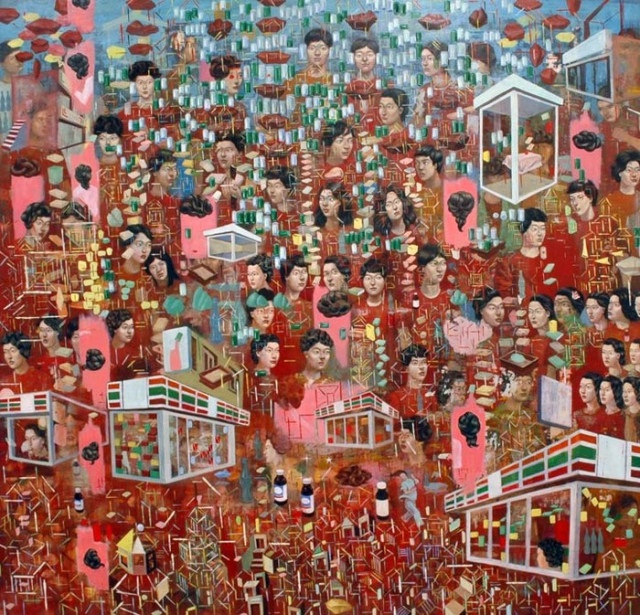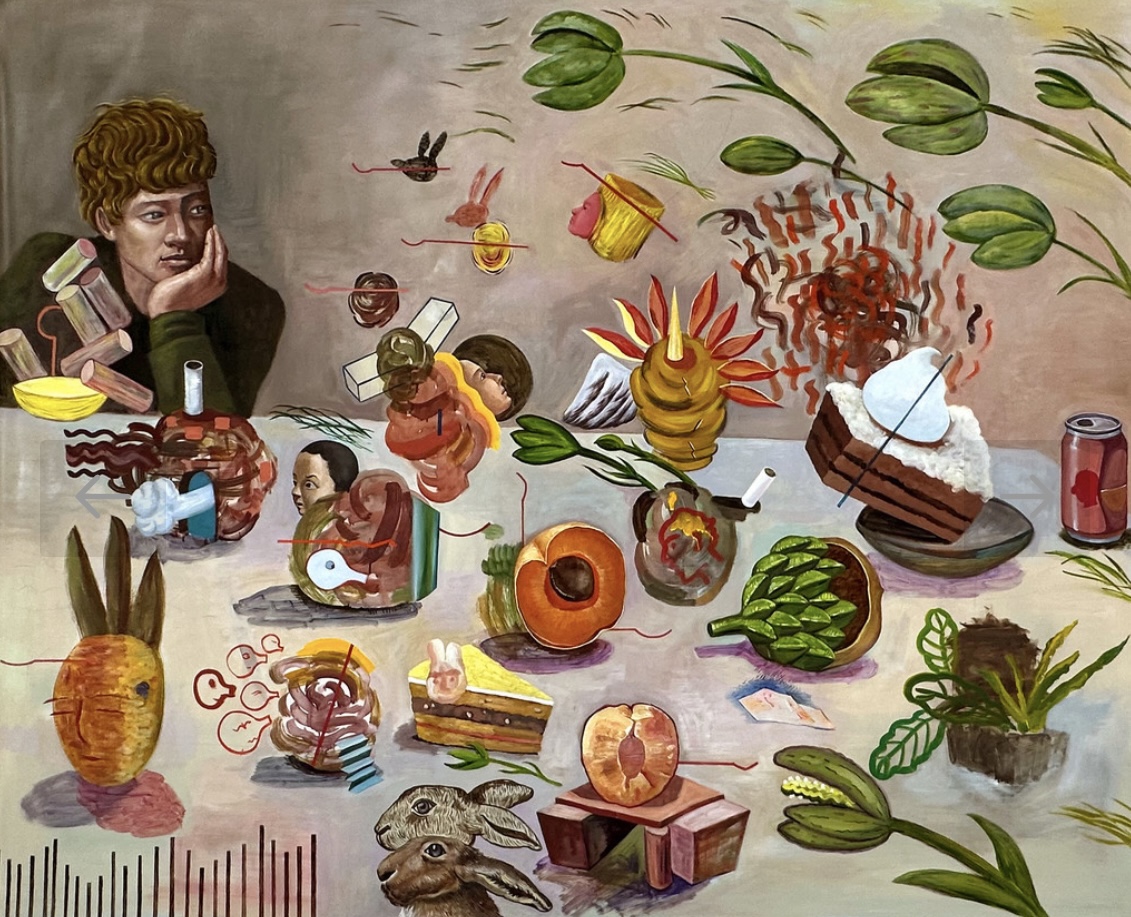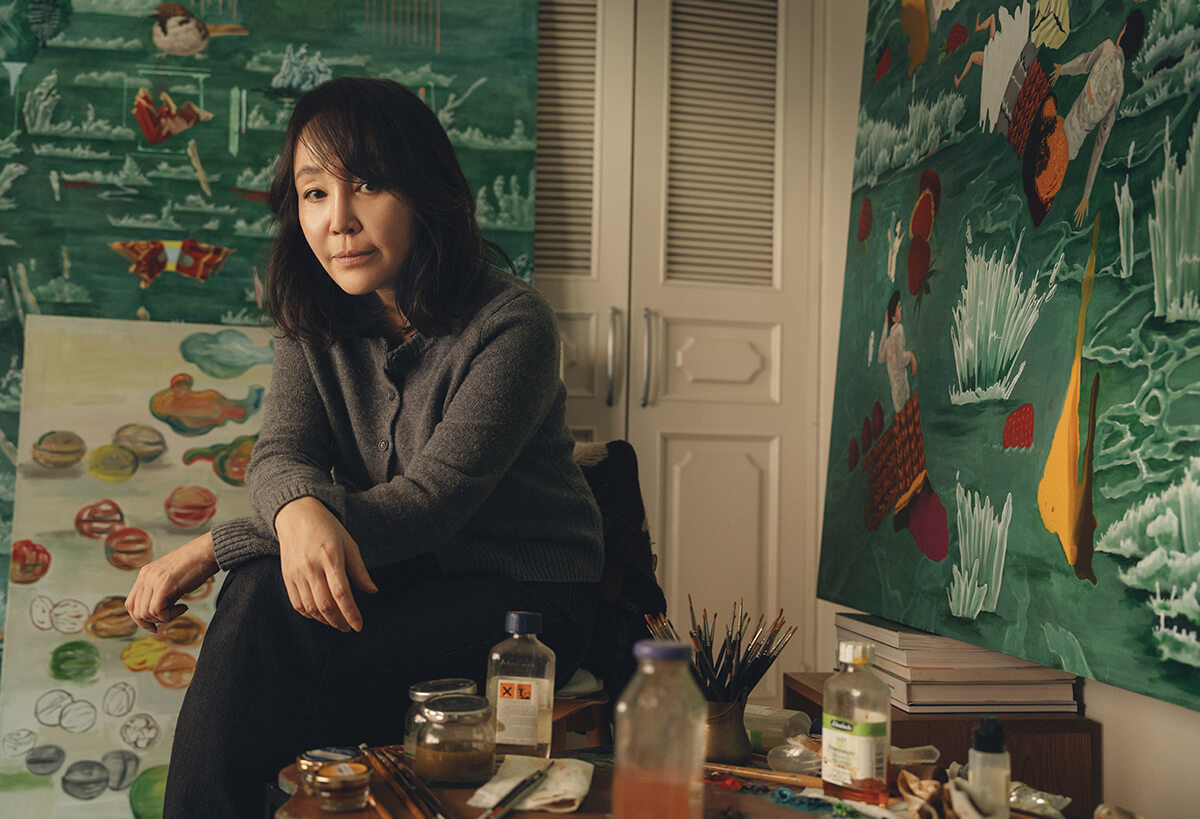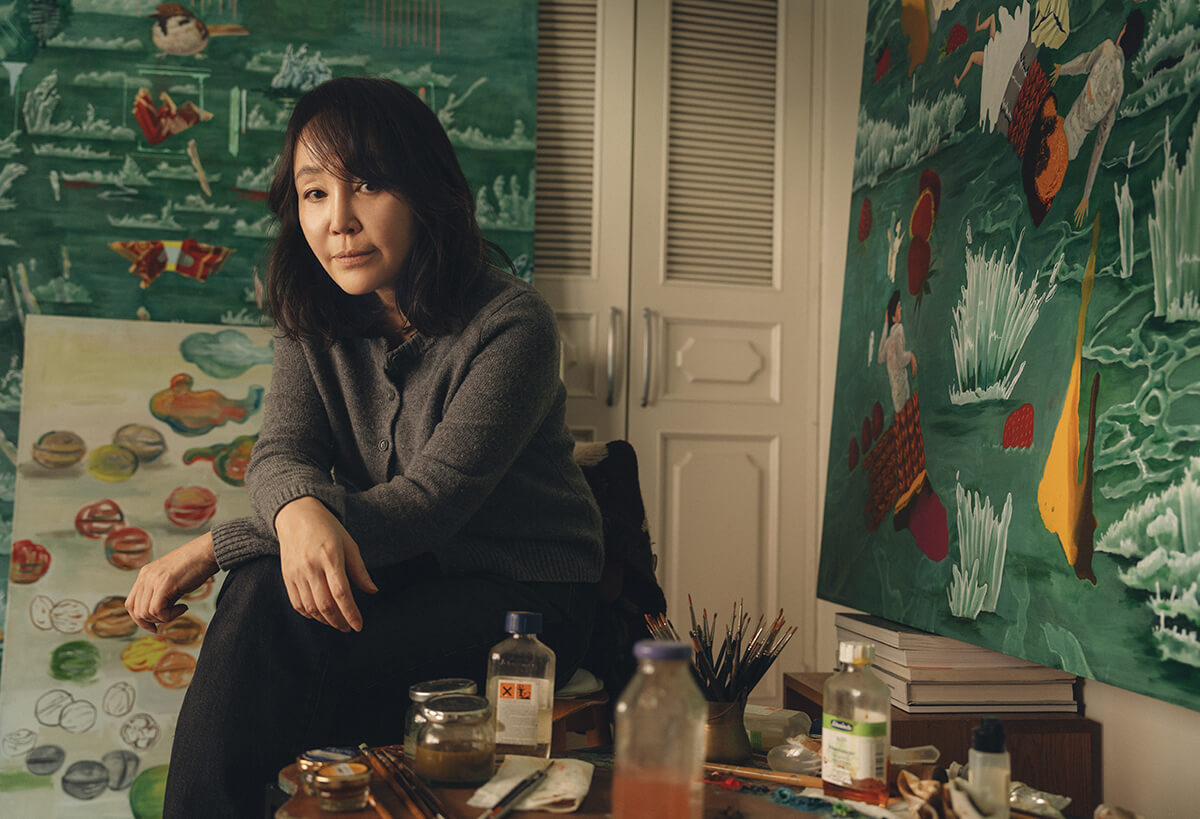Artist_K-Artist
Artist Chung Suejin’s Multi-layered Abstract Painting: An Exploration of ‘Visible Consciousness’ Created by Color and Form
October 8, 2024
A Team
Chung
Suejin (b. 1969) is one of South Korea’s leading abstract painters, known for
her thorough exploration of the unique logic and structure possible only in
painting. Viewing the inherent logic of color and form, which are the pure
visual elements of painting, as a 'visual language,' the artist has built her
own distinct artistic world through multilayered abstract works.
 Chung Suejin, Untitled,
2001 ©Gallery Skape
Chung Suejin, Untitled,
2001 ©Gallery Skape
At first glance, Chung's works may appear
to resemble figurative paintings, but a closer look reveals that there is no
narrative or sense of reality within the many images. Although they seem to be
composed of familiar everyday objects and backgrounds that feel vaguely
recognizable, they appear deconstructed or combined with disparate motifs,
resulting in a diverse blend of surreal expressions.
As viewers attempt to decode the hidden
meanings in her paintings, they eventually end in failure. This is because
Chung is not depicting anything representational, but rather purely visual
subjects. Her paintings begin with an exploration of the inherent logic of
painting itself through the combination of color and form, the most fundamental
elements of composition.
 Chung Suejin, Untitled,
2003 ©Chung Suejin
Chung Suejin, Untitled,
2003 ©Chung Suejin
From a formal perspective, Chung Suejin's
paintings lack linear perspective. Various images float freely, as if gravity
has disappeared. Chung states, “I see the flat surface, which is often
considered two-dimensional, as essentially three-dimensional.”
Noting that while we think of a flat
surface as two-dimensional, the human eye can only perceive three dimensions,
the artist shapes a multi-dimensional space on the flat surface, not through a
single perspective, but through multiple viewpoints. What may appear to be a
disorderly and perspective-less composition is, in reality, a carefully crafted
system of layered three-dimensional coordinates and grids.
 Chung Suejin, Dinner,
2006 ©ARARIO GALLERY
Chung Suejin, Dinner,
2006 ©ARARIO GALLERY
In her
2006 solo exhibition at ARARIO GALLERY, Chung presented paintings that featured
freer, more dynamic brushstrokes, in contrast to the meticulous detail that
previously filled her canvases. The works from 2006, which exude a sense of
freedom compared to the intricate depictions and multi-layered spatial
compositions of her earlier pieces, can be seen as part of Chung's exploration
of her visual language at the time.
 Chung Suejin, Brain
Ocean 5, 2000 ©Project Space Sarubia
Chung Suejin, Brain
Ocean 5, 2000 ©Project Space Sarubia
In this way, the artist has twisted the
elements of figurative painting to explore the abstract nature of painting,
grounded in its inherent visual properties. While building her unique visual
language, Chung has also continued to explore humanity, particularly human
consciousness, through her work. In this process, the canvas becomes not just a
two-dimensional plane, but a space where multidimensional time and space can
converge, and where consciousness is made visible.
 Chung Suejin, Brain
Ocean 6, 2000 ©LEE EUGEAN GALLERY
Chung Suejin, Brain
Ocean 6, 2000 ©LEE EUGEAN GALLERY
For
example, the Brain Ocean (2000) series originated from
questions about the limits of human existence and the completeness and
incompleteness of being. Chung metaphorically likens the process and space of
the ceaseless thoughts in human consciousness to a ‘Brain Ocean.’ By allowing
disparate motifs—such as waves, onions, and human figures—to coexist freely and
float or repeat on a single canvas, she encapsulates the nonlinear dimension of
human consciousness, where thoughts constantly repeat, overlap, and fade,
through the imaginative language of painting.
 Chung Suejin, Pyramid
Dialectic, 2011 ©DOOSAN Art Center
Chung Suejin, Pyramid
Dialectic, 2011 ©DOOSAN Art Center
The
methodology of visualizing the human consciousness on a flat surface, as seen
in the Brain Ocean (2000) series, has continued in her later
works. In her 2011 solo exhibition “Pyramid Dialectic,” the artist presented a
series of works that reflect the 'visual logic' she had been contemplating and
refining.
Chung
defines this 'Pyramid Dialectic' as a logic that describes the process of
'something coming from nothing' and the transition of 'the invisible becoming
visible.' She believes that just as the world before our eyes reflects human
consciousness, painting too reflects that consciousness, and this is where her
visual logic unfolds. In other words, the invisible aspects of human
consciousness become visible through various combinations of color and form,
and the flat surface thus transforms into a multidimensional world imbued with
consciousness.
 Chung Suejin, Proliferating
multidimensional creature, 2014 ©K-ARTIST.COM
Chung Suejin, Proliferating
multidimensional creature, 2014 ©K-ARTIST.COM
In her 2014 solo exhibition, Chung Suejin
published a book titled Budo Theory, which organized her
'visual theory of making the world of consciousness visible.'
Chung explains that while working on her
2006 solo exhibition, she noticed that the 'monsters' that had emerged in her
paintings continued to multiply across the canvas. This prompted her to
establish ‘Budo Theory’ as a way to define and impose order on them. The
'monsters' refer to undefined, chaotic, and unnameable forms that resist
categorization.
 Chung Suejin, Fantasy
of looking into a multidimensional world, the very first multidimensional
creature, 2012-2014 ©LEE EUGEAN GALLERY
Chung Suejin, Fantasy
of looking into a multidimensional world, the very first multidimensional
creature, 2012-2014 ©LEE EUGEAN GALLERY
Through ‘Budo Theory,’ Chung was able to
define the 'monsters' that appear on the multidimensional surface, which
visualizes the invisible world of consciousness, as 'multidimensional creatures.'
In other words, using ‘Budo Theory,’ the artist was able to bring the unknown
and chaotic entities—these monsters—into a realm of perceptibility. She later
named this the 'World of Multidimensional Creatures' and used her works to
explain the meaning structures embedded in a world of symbols and
representations.
 Chung Suejin, Ice
breaking, 2022 ©LEE EUGEAN GALLERY
Chung Suejin, Ice
breaking, 2022 ©LEE EUGEAN GALLERY
In last year's solo exhibition “The Last
Scenery of Mind” at LEE EUGEAN GALLERY, Chung Suejin presented her 20-year
exploration of the multidimensional world of consciousness through painting,
showcasing the further solidification of her ‘Budo Theory.’
Her new works from this exhibition
prominently featured expressions that emphasized the surface texture of the
paintings. For example, in Ice breaking (2022), the eye is
drawn to the large, thick red paint marks where the texture of the surface is
exposed.
The artist explains that the essential
information of a multidimensional being is revealed in the texture of the
painting’s surface. Whether in thick textures or even the smallest brushstroke,
the surface texture ultimately reflects a specific state of consciousness
perceiving the subject, allowing viewers to infer the movements of
consciousness based on this.
 =Chung Suejin, The
Last Scenery of Mind, 2023 ©LEE EUGEAN GALLERY
=Chung Suejin, The
Last Scenery of Mind, 2023 ©LEE EUGEAN GALLERY
“The
information transmitted by colors, forms, and shapes that make up a painting is
not a specific meaning, but a structure of meaning. The structure of this
meaning acts as a vessel of one's own interpretation. Freedom of interpretation
is within the limits of the structure of the vessel.
That
means that each freedom to derive a specific meaning is within the limits of
the structure of the meaning. What the picture presents is the structure of
meaning. It is up to the viewer to decide what to include in the structure of
meaning. This is why many interpretations are possible in a single painting.”
 Artist Chung
Suejin ©Nobless
Artist Chung
Suejin ©Nobless
Currently
actively working between Seoul and New York, Chung Suejin graduated from the
Painting Department at Hongik University and earned her MFA in Painting from
the School of the Art Institute of Chicago. She held her first solo exhibition
in 1999 at Cigong Gallery in Daegu and has since had solo shows at Project
Space SARUBIA, ARARIO GALLERY, Doosan Gallery, Mongin Art Center, and Gallery
Skape.
She has
also participated in group exhibitions at venues such as the National Museum of
Modern and Contemporary Art, the Tirana Biennale, the BizArt Center in
Shanghai, and the Busan Museum of Art. Her works are included in collections at
the National Museum of Modern and Contemporary Art (Gwacheon), Arts Council
Korea (Seoul), Doosan Art Center-Yonkang Foundation (Seoul), Seonhwa Art and
Culture Foundation (Seoul), and the Long Museum (Shanghai, China).
Articles






























